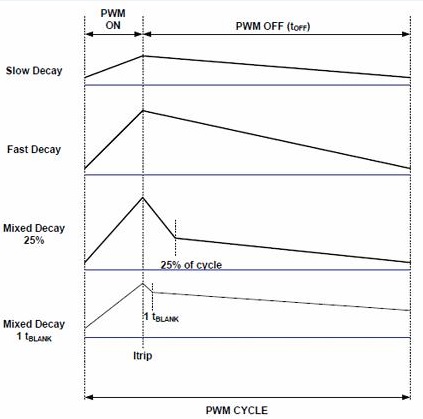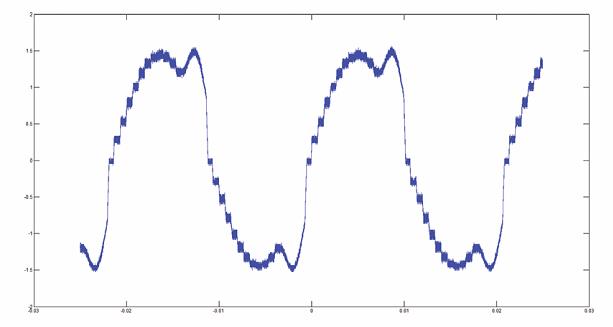This post sponsored by Texas Instruments.
Bipolar stepper motors are used almost universally these days for applications requiring cost effective speed and position control. The precise control of each phase current allows for not only full step performance but also fractional stepping, A.K.A. micro-stepping. Micro-stepping is a common technique used to reduce motion vibration and audible noise as well as eliminate resonance issues.
However, micro-stepping performance can be greatly reduced if re-circulating currents are not properly controlled. Slow, fast and mixed decay schemes have traditionally been used to achieve optimal performance, but as these are static schemes, they fall short in many instances, especially when it comes to variable loading or variable speed and position motion profiles.
Decay mode tuning allows designers to accurately control stepper output current, which ultimately determines motion performance. The issue with static decay schemes is that they are optimal for one set of conditions and as mentioned above, are not optimal over the wide range of loads and motion profiles that stepper motors may need to support.
An intelligent decay scheme can now be integrated inside motor-drive circuits that dynamically selects the proper decay settings for optimal performance based on motion requirements. This greatly simplifies if not eliminates the tuning process and delivers optimal performance over the complete range of possible motion profiles.
Definition of terms
The term “decay” is a reference to the inductive current decaying in value when the applied motor voltage is suddenly turned off. The current can decay either slowly (I.E. slow decay) or decay fast (I.E. fast decay). Inductors don’t like sudden changes in current and will keep current flowing as long as they are energized, albeit at a decreasing rate. When controlling a stepper motor via current chopping or pule-width-modulation (PWM), you are rapidly turning the motor voltage on and off and during the PWM off cycle, decay modes are active. (Figure 1)

Figure 1: Different decay schemes can be used to control the current levels. Note the difference in current levels at the trip point and the end of the PWM cycle; also please note the above currents are not to scale. (Source: Texas Instruments)
In a slow-decay scheme, the current is re-circulated using both low-side FETs, which slowly decreases the current. In fast decay, a reverse supply voltage is applied to decrease current more rapidly. This reduces current flow but can introduce larger ripple currents, reducing overall regulation efficiency.
Mixing slow- and fast-decay modes begins by utilizing the fast mode, but switches to slow mode at a predetermined interval. This mixed-fixed decay scheme give the user quite a bit of flexibility in tuning the motor, especially if the mixed decay ratio is adjustable (I.E. percent of fast vs slow decay is configurable).
When micro-stepping, the key to optimal performance is for the motor driver to output a clean, undistorted sine wave. The less distortion the better the performance. And the key to minimizing distortion is selecting the proper decay modes that insure the motor driver outputs a clean, undistorted current sine wave.
A better mousetrap
Knowing how your system performs is the first step to optimizing it. By monitoring the current on an oscilloscope, you can test the available fixed-decay options. While this can be a bit time consuming, eventually you will end up with a set of decay modes that enables optimal performance for the given motion profile. For constant load / motion requirements, this can provide very good performance.
Another technique modern controllers can use is to constantly monitor the motor output current and dynamically select the most optimal decay mode for that particular instant. This selection process takes into account the speed, motor voltage, microstepping level, BEMF, etc. It is important to note that this technique can compensate for the back EMF from the coil windings, which is directly dependent on the motor speed. (Figures 2a and 2b) Figure 2a: Back EMF can cause distortion in driving waveform which can translate into vibration, heat and using more power than needed. (Source: Texas Instruments)
Figure 2a: Back EMF can cause distortion in driving waveform which can translate into vibration, heat and using more power than needed. (Source: Texas Instruments)
 Figure 2b: Controlled-decay techniques can compensate for the back EMF and restore a clean waveform. (Source: Texas Instruments)
Figure 2b: Controlled-decay techniques can compensate for the back EMF and restore a clean waveform. (Source: Texas Instruments)
Devices like the Texas Instruments DRV8846 perform these functions digitally. As a result, the motors require no tuning and the decay setting is modified in real time, including current level, step change, supply and BEMF load.
Design resources like parametric search engines and white papers are also available from Texas Instruments, as are community forums and blogs.
UCC28711
For more information about this product, click here.
To request a sample, click here.  To buy now at Mouser, click here.
To buy now at Mouser, click here.
DRV110
For more information about this product, click here.
To request a sample, click here.  To buy now at Mouser, click here.
To buy now at Mouser, click here.
DRV8846
For more information about this product, click here.
To request a sample, click here.  To buy now at Mouser, click here.
To buy now at Mouser, click here.
ADS7854
For more information about this product, click here.
To request a sample, click here.  To buy now at Mouser, click here.
To buy now at Mouser, click here.
DRV8825
For more information about this product, click here.
To request a sample, click here.  To buy now at Mouser, click here.
To buy now at Mouser, click here.
DRV8846
For more information about this product, click here.
To request a sample, click here.  To buy now at Mouser, click here.
To buy now at Mouser, click here.
DRV8307
For more information about this product, click here.
To request a sample, click here. 
To buy now at Mouser, click here.
Author: Jon Gabay, Hearst Business Media
Advertisement
Learn more about Texas Instruments





